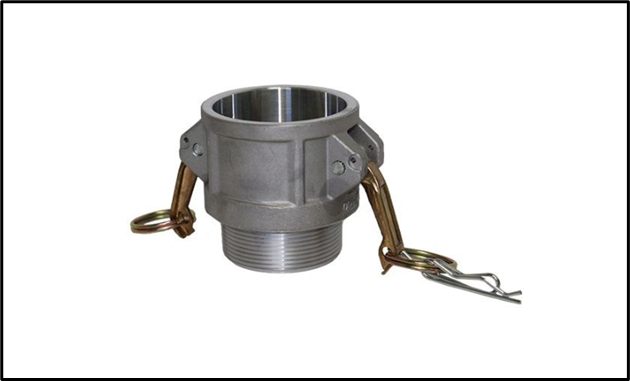When it comes to working in a fluid handling industry, choosing the right coupling method becomes mandatory. Camlock fittings ensure the whole working environment’s efficiency, safety, and reliability. The two prominent options that you may often see in the market are camlock fittings and traditional couplings. While the world has moved forward, some people are still using traditional couplings.
On the other hand, modern-day industries are now trusting camlock fittings. Each has its unique set of advantages and applications, but the question pops up: Which one is the better choice for your needs? This blog will dive into the features, benefits, and drawbacks of 2” camlock fittings and traditional couplings. After reading this blog, you may be able to make an informed decision.
Understanding Camlock Fittings:
What Are Camlock Fittings?
Camlock fittings, also known as cam and groove couplings, are a type of quick-connect coupling used in various industries to connect hoses and pipes securely and swiftly. These fittings are also widely used in industries such as agriculture, oil, manufacturing, and firefighting. Let’s discuss their workings.
How Do Cam Fittings Work?
Camlock fittings consist of two main components. One is the male camlock or adapter, also known as the plug. The other is the female coupler. Connecting these two components is quite simple.
Insert the male adapter into the female coupler.
Pull the cam arms down to lock the connection. This mechanism ensures a secure and leak-proof connection without additional tools or equipment.
Benefits of Camlock Fittings
- Ease of Use: Camlock fittings are designed for quick and efficient coupling and decoupling. The simple locking mechanism allows for fast connections and disconnections, saving valuable time in high-paced environments.
- Versatility: Available in various materials, including stainless steel, brass, aluminum, and polypropylene, Camlock fittings can handle a wide range of fluids and gases, making them suitable for diverse applications.
- Leak-Proof: The design of Camlock fittings ensures a tight seal, minimizing the risk of leaks and spills, which is crucial for maintaining safety and efficiency.
- Durability: Built to withstand harsh conditions, Camlock fittings are known for their longevity and resistance to corrosion, wear, and tear.
- Cost-Effective: With their ease of use and durability, Camlock fittings often reduce maintenance costs and downtime, leading to long-term savings.
Explore The Traditional Couplings
What are Traditional Couplings?
Traditional couplings refer to a broad category of connectors that includes many types of couplings. These include threaded couplings, flanges, and compression fittings. These couplings have been used for decades in various industries to connect pipes and hoses securely.
Types of Traditional Couplings
- Threaded Couplings: These couplings use screw threads to connect pipes and are commonly seen in plumbing and gas systems.
- Flange Couplings: Utilized in high-pressure applications, flange couplings involve bolting two flanges together with a gasket in between to ensure a tight seal.
- Compression Fittings: Often used in plumbing, compression fittings use a nut and ferrule to compress the pipe, creating a tight seal.
Benefits of Traditional Couplings
- Strong & Reliable: One of the most regarded benefits of traditional couplings, especially flanged connections, is that they provide strong and reliable connections. They are very capable of handling high pressures and heavy loads.
- Wide Availability: Another reason to trust them is their wide range of availability. Being in use for many years, these traditional couplings are widely available and come in various sizes and materials.
- Customizability: Customization is a factor that greatly benefits many industries. Traditional couplings can be tailored to specific applications, offering flexibility in design and material choice.
- Proven Technology: Lastly, traditional couplings have a long history of use and a proven track record of performance and reliability. They have been trusted by thousands of industry professionals and are still used in many industries today.
Comparing Camlock Fittings and Traditional Couplings
Let’s compare the two:
Installation and Maintenance
- Camlock Fittings: These are incredibly easy to install and require minimal tools. Maintenance is straightforward due to their simple design.
- Traditional Couplings: Installation can be more labor-intensive and might require specialized tools. Maintenance can also be more complex, particularly for threaded and flanged connections.
Versatility
- Camlock Fittings: Highly versatile, they can be used with a wide range of fluids and gases and are suitable for various industry applications.
- Traditional Couplings: While versatile, the specific type of traditional coupling chosen must match the application, which can complicate selection.
Durability and Reliability
- Camlock Fittings: Known for their durability and resistance to corrosion, they offer reliable performance over time.
- Traditional Couplings: Also durable and reliable, particularly in high-pressure and heavy-duty applications, but may require more frequent maintenance.
- Cost: Camlock Fittings: Generally more cost-effective in terms of installation and maintenance, leading to long-term savings.
- Traditional Couplings: Initial costs might be lower, but increased maintenance and potential downtime can add to the long-term expenses.
Which One Is Better?
The choice between Camlock fittings and traditional couplings ultimately depends on your specific needs and applications.
- Choose Camlock Fittings if You require quick and easy installation, versatility, and a cost-effective solution for a variety of fluids and gases.
- Choose Traditional Couplings if You need strong, reliable connections for high-pressure applications and are willing to invest in more complex installation and maintenance processes.
Final Words!
Both options offer distinct benefits, and understanding these can guide you toward the best choice for your operations. Evaluate your requirements carefully, considering ease of use, durability, versatility, and cost to make an informed decision that enhances efficiency and safety in your fluid handling systems.
